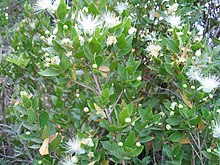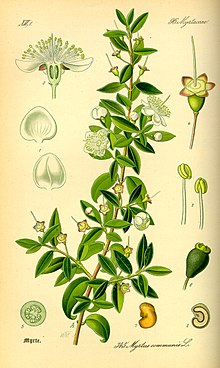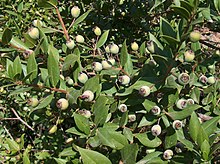Myrtus: Perbedaan antara revisi
k Bot: Perubahan kosmetika |
k →top: tanpa takson -> klad + clean up |
||
| (8 revisi perantara oleh 4 pengguna tidak ditampilkan) | |||
| Baris 1: | Baris 1: | ||
{{For|asteroid|9203 Myrtus}} |
{{For|asteroid|9203 Myrtus}} |
||
{{italic title}} |
{{italic title}} |
||
{{ |
{{Taxobox |
||
| color = {{tc2|tumbuhan}} |
|||
| |
|name = ''Myrtus''<br/>Murad |
||
| |
|image = Myrtus_communis.jpg |
||
| image_caption = ''[[Myrtus communis]]'' |
|||
| |
|image_caption = ''[[Myrtus communis]]'' |
||
|image2 = Illustration Myrtus communis0.jpg |
|||
| |
|image2_caption = '''Murad''' (''M.communis'')<ref>Ilustrasi tahun 1885 dari Prof. Dr. Otto Wilhelm Thomé "''Flora von Deutschland, Österreich und der Schweiz''" 1885, Gera, [[Jerman]]</ref> |
||
| regnum = [[Plantae]] |
|||
| |
|regnum = [[Plantae]] |
||
{{kladtb|[[Tumbuhan berpembuluh|Tracheophyta]]}} |
|||
| unranked_classis = [[Eudikotil]] |
|||
{{kladtb|[[Tumbuhan berbunga|Angiospermae]]}} |
|||
| unranked_ordo = [[Rosid]] |
|||
{{kladtb|[[Eudikotil]]}} |
|||
| ⚫ | |||
{{kladtb|[[Rosid]]}} |
|||
| ⚫ | |||
| ⚫ | |||
| ⚫ | |||
| ⚫ | |||
| genus_authority = [[Carolus Linnaeus|L.]] |
|||
| ⚫ | |||
| subdivision_ranks = Species |
|||
| subdivision = '''''[[Myrtus communis]]''''' <small>[[Carolus Linnaeus|L.]]</small><br/>'''''[[Myrtus nivellei]]''''' <small>Batt. & Trab.</small> |
|genus_authority = [[Carolus Linnaeus|L.]] |
||
|subdivision_ranks = Species |
|||
|subdivision = '''''[[Myrtus communis]]''''' <small>[[Carolus Linnaeus|L.]]</small><br/>'''''[[Myrtus nivellei]]''''' <small>Batt. & Trab.</small> |
|||
| |
|synonyms_ref = <ref name=j/> |
||
| |
|synonyms = ''[[Myrthus]]'' <small>Scop.</small> |
||
|type_species=''Myrtus communis'' |
|type_species=''Myrtus communis'' |
||
|type_species_authority=[[Carolus Linnaeus|L.]]<ref>lectotype designated by A.P. de Candolle, Note Myrt. 7 (1826)</ref><ref name=u/> |
|type_species_authority=[[Carolus Linnaeus|L.]]<ref>lectotype designated by A.P. de Candolle, Note Myrt. 7 (1826)</ref><ref name=u/> |
||
| Baris 40: | Baris 42: | ||
The plant is an [[evergreen]] [[shrub]] or small [[tree]], growing to {{convert|5|m|ft}} tall. The [[leaf]] is entire, 3–5 cm long, with a fragrant [[essential oil]]. |
The plant is an [[evergreen]] [[shrub]] or small [[tree]], growing to {{convert|5|m|ft}} tall. The [[leaf]] is entire, 3–5 cm long, with a fragrant [[essential oil]]. |
||
The star-like [[flower]] has five petals and sepals, and numerous [[stamen]]s. Petals usually are white. |
The star-like [[flower]] has five petals and sepals, and numerous [[stamen]]s. Petals usually are white. The flower is pollinated by [[insect]]s. |
||
The fruit is a round [[berry]] containing several [[seed]]s, most commonly blue-black in colour. A variety with yellow-amber berries is also present. The seeds are dispersed by [[bird]]s that eat the berries. |
The fruit is a round [[berry]] containing several [[seed]]s, most commonly blue-black in colour. A variety with yellow-amber berries is also present. The seeds are dispersed by [[bird]]s that eat the berries. |
||
| Baris 60: | Baris 62: | ||
Jika lebih jarang dicukur, bunganya lebat pada akhir musim panas. Membutuhkan musim panas yang lama dan terik untuk menghasilkan bunga, dan perlu dilindungi dari ''frost'' musim dingin. |
Jika lebih jarang dicukur, bunganya lebat pada akhir musim panas. Membutuhkan musim panas yang lama dan terik untuk menghasilkan bunga, dan perlu dilindungi dari ''frost'' musim dingin. |
||
Spesies dan [[subspesies]] ''M. |
Spesies dan [[subspesies]] ''M.communis'' subsp. ''tarentina'' telah memperoleh penghargaan [[:en:Award of Garden Merit|Award of Garden Merit]] dari [[:en:Royal Horticultural Society|Royal Horticultural Society]].<ref>{{cite web|title=RHS Plant Selector - ''Myrtus communis''|url=http://apps.rhs.org.uk/plantselector/plant?plantid=1305|accessdate=25 May 2013|archive-date=2014-01-10|archive-url=https://web.archive.org/web/20140110091431/http://apps.rhs.org.uk/plantselector/plant?plantid=1305|dead-url=yes}}</ref><ref>{{cite web|title=RHS Plant Selector - ''Myrtus communis'' subsp. ''tarentina''|url=http://apps.rhs.org.uk/plantselector/plant?plantid=3456|accessdate=25 May 2013|archive-date=2014-01-10|archive-url=https://web.archive.org/web/20140110091534/http://apps.rhs.org.uk/plantselector/plant?plantid=3456|dead-url=yes}}</ref> |
||
=== Makanan === |
=== Makanan === |
||
''Myrtus communis'' digunakan di pulau [[Sardinia]] dan [[Corsica]] untuk menghasilkan minuman keras beraroma yang disebut [[:en:Mirto (drink)|''Mirto'']] dengan cara [[:en:macerating|maserasi]] dalam [[alkohol]]. ''Mirto'' merupakan salah satu minuman khas Sardinia, tersedia dalam dua varietas: ''mirto rosso'' (merah) dihasilkan dari maserasi buah (''berries''), dan ''mirto bianco'' (putih) dihasilkan dari buah kuning, bahkan daun-daun, yang kurang lazim ditemukan.<ref>{{cite web|url=http://it.wiki-indonesia.club/wiki/Liquore_di_mirto | |
''Myrtus communis'' digunakan di pulau [[Sardinia]] dan [[Corsica]] untuk menghasilkan minuman keras beraroma yang disebut [[:en:Mirto (drink)|''Mirto'']] dengan cara [[:en:macerating|maserasi]] dalam [[alkohol]]. ''Mirto'' merupakan salah satu minuman khas Sardinia, tersedia dalam dua varietas: ''mirto rosso'' (merah) dihasilkan dari maserasi buah (''berries''), dan ''mirto bianco'' (putih) dihasilkan dari buah kuning, bahkan daun-daun, yang kurang lazim ditemukan.<ref>{{cite web|url=http://it.wiki-indonesia.club/wiki/Liquore_di_mirto |title=Liquore di mirto|accessdate=2007-06-18|publisher=Italian Wikipedia|language=Italian}}</ref> |
||
Buah-buahnya (''berries''), utuh atau digiling, telah digunakan sebagai pengganti [[merica]].<ref>{{cite web |url= http://theepicentre.com/spice/myrtle/ |title= Myrtle |author=<!--Staff writer(s); no by-line.--> |date= |
Buah-buahnya (''berries''), utuh atau digiling, telah digunakan sebagai pengganti [[merica]].<ref>{{cite web |url= http://theepicentre.com/spice/myrtle/ |title= Myrtle |author=<!--Staff writer(s); no by-line.--> |date= |website= The Epicentre |publisher= |accessdate= 16 July 2014}}</ref> |
||
=== Obat-obatan === |
=== Obat-obatan === |
||
| Baris 71: | Baris 73: | ||
Murad menempati posisi utama dalam tulisan-tulisan [[Hippocrates]], [[Plinius yang Tua|Plinius]], [[:en:Dioscorides|Dioscorides]], [[Galen]], dan penulis-penulis Arab.<ref>Pharmacographia Indica (1891 edition), London</ref> |
Murad menempati posisi utama dalam tulisan-tulisan [[Hippocrates]], [[Plinius yang Tua|Plinius]], [[:en:Dioscorides|Dioscorides]], [[Galen]], dan penulis-penulis Arab.<ref>Pharmacographia Indica (1891 edition), London</ref> |
||
Di beberapa negara, terutama di Eropa and Tiongkok, ada tradisi untuk menggunakan bahan ini dalam pengobatan infeksi hidung (''sinus infections''). Suatu tinjauan sistematik obat-obatan tanaman yang digunakan untuk mengobati [[:en:rhinosinusitis|rhinosinusitis]] menyimpulkan bahwa bukti manfaat tanaman obat dalam pengobatan rhinosinusitis jumlahnya terbatas, dan tidak cukup bukti dari ''Myrtus'' untuk memastikan signifikansi hasil klinik.<ref>{{cite journal | |
Di beberapa negara, terutama di Eropa and Tiongkok, ada tradisi untuk menggunakan bahan ini dalam pengobatan infeksi hidung (''sinus infections''). Suatu tinjauan sistematik obat-obatan tanaman yang digunakan untuk mengobati [[:en:rhinosinusitis|rhinosinusitis]] menyimpulkan bahwa bukti manfaat tanaman obat dalam pengobatan rhinosinusitis jumlahnya terbatas, dan tidak cukup bukti dari ''Myrtus'' untuk memastikan signifikansi hasil klinik.<ref>{{cite journal |pmid = 17011407 |year = 2006 |last1 = Guo |first1 = R |last2 = Canter |first2 = PH |last3 = Ernst |first3 = E |title = Herbal medicines for the treatment of rhinosinusitis: A systematic review |volume = 135 |issue = 4 |pages = 496–506 |doi = 10.1016/j.otohns.2006.06.1254 |journal = Otolaryngology--head and neck surgery : official journal of American Academy of Otolaryngology-Head and Neck Surgery}}</ref> |
||
<!-- |
<!-- |
||
===In myth and ritual===--> |
===In myth and ritual===--> |
||
| Baris 82: | Baris 84: | ||
In Rome, Virgil explains that “the poplar is most dear to Alcides, the vine to Bacchus, the myrtle to lovely Venus, and his own [[Bay Laurel|laurel]] to Phoebus.”<ref>Virgil, [[Eclogue]] VII.61-63.</ref> At the [[Veneralia]], women bathed wearing crowns woven of myrtle branches, and myrtle was used in wedding rituals. In the [[Aeneid]], myrtle marks the grave of the murdered [[Polydorus (son of Priam)|Polydorus]] in Thrace. Aeneus' attempts to uproot the shrub cause the ground to bleed, and the voice of his dead brother warns him to leave. The spears which impaled Polydorus have been magically transformed into the myrtle which marks his grave.<ref>[http://www.poetryintranslation.com/PITBR/Latin/VirgilAeneidIII.htm#_Toc536528096 ''Aeneid III, 19-68''], accessed 13 March 2014</ref> |
In Rome, Virgil explains that “the poplar is most dear to Alcides, the vine to Bacchus, the myrtle to lovely Venus, and his own [[Bay Laurel|laurel]] to Phoebus.”<ref>Virgil, [[Eclogue]] VII.61-63.</ref> At the [[Veneralia]], women bathed wearing crowns woven of myrtle branches, and myrtle was used in wedding rituals. In the [[Aeneid]], myrtle marks the grave of the murdered [[Polydorus (son of Priam)|Polydorus]] in Thrace. Aeneus' attempts to uproot the shrub cause the ground to bleed, and the voice of his dead brother warns him to leave. The spears which impaled Polydorus have been magically transformed into the myrtle which marks his grave.<ref>[http://www.poetryintranslation.com/PITBR/Latin/VirgilAeneidIII.htm#_Toc536528096 ''Aeneid III, 19-68''], accessed 13 March 2014</ref> |
||
In the Mediterranean, myrtle was symbolic of love and immortality. |
In the Mediterranean, myrtle was symbolic of love and immortality. In their culture the plant was used extensively and was considered an essential plant. |
||
;Jewish |
;Jewish |
||
In [[Jewish liturgy]], it is one of the four sacred plants of [[Sukkot]], the [[Feast of Tabernacles]] representing the different types of personality making up the community - the myrtle having fragrance but not pleasant taste, represents those who have good deeds to their credit despite not having knowledge from [[Torah]] study. Three branches are held by the worshippers along with a [[citron]], a [[Palm tree|palm]] leaf, and two [[willow]] branches. In [[Jewish mysticism]], the myrtle represents the phallic, masculine force at work in the universe. For this reason myrtle branches were sometimes given the bridegroom as he entered the nuptial chamber after a wedding (Tos. Sotah 15:8; Ketubot 17a). Myrtles are both the symbol and scent of [[Garden of Eden|Eden]] (BhM II: 52; Sefer ha-Hezyonot 17). The [[Hechalot]] text Merkavah Rabbah requires one to suck on a myrtle leaves as an element of a theurgic ritual. Kabbalists link myrtle to the sefirah of Tiferet and use sprigs in their Shabbat (especially Havdalah) rites to draw down its harmonizing power as the week is initiated (Shab. 33a; Zohar Chadash, SoS, 64d; Sha’ar ha-Kavvanot, 2, pp. 73–76).<ref>[[List of plants in the Bible]]</ref> |
In [[Jewish liturgy]], it is one of the four sacred plants of [[Sukkot]], the [[Feast of Tabernacles]] representing the different types of personality making up the community - the myrtle having fragrance but not pleasant taste, represents those who have good deeds to their credit despite not having knowledge from [[Torah]] study. Three branches are held by the worshippers along with a [[citron]], a [[Palm tree|palm]] leaf, and two [[willow]] branches. In [[Jewish mysticism]], the myrtle represents the phallic, masculine force at work in the universe. For this reason myrtle branches were sometimes given the bridegroom as he entered the nuptial chamber after a wedding (Tos. Sotah 15:8; Ketubot 17a). Myrtles are both the symbol and scent of [[Garden of Eden|Eden]] (BhM II: 52; Sefer ha-Hezyonot 17). The [[Hechalot]] text Merkavah Rabbah requires one to suck on a myrtle leaves as an element of a theurgic ritual. Kabbalists link myrtle to the sefirah of Tiferet and use sprigs in their Shabbat (especially Havdalah) rites to draw down its harmonizing power as the week is initiated (Shab. 33a; Zohar Chadash, SoS, 64d; Sha’ar ha-Kavvanot, 2, pp. 73–76).<ref>[[List of plants in the Bible]]</ref> |
||
Myrtle leaves were added to the water in the last (7th) rinsing of the head in the traditional Sephardic tahara manual (teaching the ritual for washing the dead). |
Myrtle leaves were added to the water in the last (7th) rinsing of the head in the traditional Sephardic tahara manual (teaching the ritual for washing the dead).<ref>Service for Preparing the Dead for Burial, as Used in the Spanish and Portuguese Congregation, Shearith Israel, NY City, Published by the Society "Hebra Hased ba'Amet", New York, 1913, available at www.Jewish-Funerals.org</ref> |
||
;Contemporary |
;Contemporary |
||
| Baris 96: | Baris 98: | ||
==Garden history==--> |
==Garden history==--> |
||
[[Berkas:Gardenology.org-IMG 2781 rbgs11jan.jpg|jmpl|''M. |
[[Berkas:Gardenology.org-IMG 2781 rbgs11jan.jpg|jmpl|''M.communis'' ssp. ''tarentina'' cv. 'compacta' di sebuah kebun]] |
||
<!-- |
<!-- |
||
===Rome=== |
===Rome=== |
||
| Baris 124: | Baris 126: | ||
== Referensi == |
== Referensi == |
||
{{Reflist|2}} |
{{Reflist|2}} |
||
{{Taxonbar|from=Q165152}} |
|||
[[Kategori:Myrtus| ]] |
[[Kategori:Myrtus| ]] |
||
Revisi terkini sejak 29 Juni 2024 13.24
| Myrtus Murad | |
|---|---|

| |
| Myrtus communis | |

| |
| Murad (M.communis)[1] | |
| Klasifikasi ilmiah | |
| Kerajaan: | |
| Klad: | Tracheophyta |
| Klad: | Angiospermae |
| Klad: | Eudikotil |
| Klad: | Rosid |
| Ordo: | |
| Famili: | |
| Genus: | Myrtus |
| Spesies tipe | |
| Myrtus communis | |
| Species | |
|
Myrtus communis L. | |
| Sinonim[4] | |
|
Myrthus Scop. | |

Myrtus, dengan nama umum murad (bahasa Inggris: myrtle) merupakan suatu genus tumbuhan bunga dalam familia Myrtaceae. Pertama kali dipaparkan oleh Linnaeus pada tahun 1753.[3]
Taksonomi
[sunting | sunting sumber]Lebih dari 600 nama pernah diusulkan termasuk ke dalam genus ini, tetapi hampir semuanya telah dipindahkan ke genus lain atau dianggap sinonim.
Genus Myrtus beranggotakan 2 spesies yang dikenal sekarang:[4]
- Myrtus communis — "Murad umum" (Common myrtle); tumbuhan asli di daerah Laut Tengah di bagian selatan Eropa.
- Myrtus nivellei — "Murad sahara" (Saharan myrtle); tumbuhan asli di Afrika Utara.
Pemerian
[sunting | sunting sumber]Murad umum
[sunting | sunting sumber]Myrtus communis, atau Murad umum (juga disebut true myrtle; "murad sejati"), merupakan tumbuhan asli di bagian utara Mediterania (terutama di pulau Sardinia dan Corsica, di mana memiliki nama setempat murta).[5]
Murad sahara
[sunting | sunting sumber]Myrtus nivellei atau Murad sahara, (bahasa Tuareg: tefeltest), tumbuh endemik di pengunungan Gurun Sahara tengah.[6]
Penggunaan
[sunting | sunting sumber]Pembiakan
[sunting | sunting sumber]Myrtus communis, dibiakkan luas sebagai suatu tanaman hias dalam bentuk perdu di kebun dan taman. Sering menjadi tanaman pagar, di mana daun-daun kecilnya dicukur rapi.
Jika lebih jarang dicukur, bunganya lebat pada akhir musim panas. Membutuhkan musim panas yang lama dan terik untuk menghasilkan bunga, dan perlu dilindungi dari frost musim dingin.
Spesies dan subspesies M.communis subsp. tarentina telah memperoleh penghargaan Award of Garden Merit dari Royal Horticultural Society.[7][8]
Makanan
[sunting | sunting sumber]Myrtus communis digunakan di pulau Sardinia dan Corsica untuk menghasilkan minuman keras beraroma yang disebut Mirto dengan cara maserasi dalam alkohol. Mirto merupakan salah satu minuman khas Sardinia, tersedia dalam dua varietas: mirto rosso (merah) dihasilkan dari maserasi buah (berries), dan mirto bianco (putih) dihasilkan dari buah kuning, bahkan daun-daun, yang kurang lazim ditemukan.[9]
Buah-buahnya (berries), utuh atau digiling, telah digunakan sebagai pengganti merica.[10]
Obat-obatan
[sunting | sunting sumber]
Murad menempati posisi utama dalam tulisan-tulisan Hippocrates, Plinius, Dioscorides, Galen, dan penulis-penulis Arab.[11]
Di beberapa negara, terutama di Eropa and Tiongkok, ada tradisi untuk menggunakan bahan ini dalam pengobatan infeksi hidung (sinus infections). Suatu tinjauan sistematik obat-obatan tanaman yang digunakan untuk mengobati rhinosinusitis menyimpulkan bahwa bukti manfaat tanaman obat dalam pengobatan rhinosinusitis jumlahnya terbatas, dan tidak cukup bukti dari Myrtus untuk memastikan signifikansi hasil klinik.[12]



Pranala luar
[sunting | sunting sumber]
|
- Myrtle (Myrtus communis L.), from Gernot Katzer's Spice Pages
- www.myrtus-communis.de (German)
- Myrtus in Flora Europaea
Referensi
[sunting | sunting sumber]- ^ Ilustrasi tahun 1885 dari Prof. Dr. Otto Wilhelm Thomé "Flora von Deutschland, Österreich und der Schweiz" 1885, Gera, Jerman
- ^ lectotype designated by A.P. de Candolle, Note Myrt. 7 (1826)
- ^ a b Tropicos, Myrtus L.
- ^ a b Kew World Checklist of Selected Plant Families
- ^ Altervista Flora Italiana, Mirto comune, Myrtaceae: Myrtus communis L. termasuk foto dan peta distribusi di Eropa.
- ^ Uicnmed.org: Myrtus nivellei - Batt & Trab. - Myrtaceae . accessed 1.10.2014.
- ^ "RHS Plant Selector - Myrtus communis". Diarsipkan dari versi asli tanggal 2014-01-10. Diakses tanggal 25 May 2013.
- ^ "RHS Plant Selector - Myrtus communis subsp. tarentina". Diarsipkan dari versi asli tanggal 2014-01-10. Diakses tanggal 25 May 2013.
- ^ "Liquore di mirto" (dalam bahasa Italian). Italian Wikipedia. Diakses tanggal 2007-06-18.
- ^ "Myrtle". The Epicentre. Diakses tanggal 16 July 2014.
- ^ Pharmacographia Indica (1891 edition), London
- ^ Guo, R; Canter, PH; Ernst, E (2006). "Herbal medicines for the treatment of rhinosinusitis: A systematic review". Otolaryngology--head and neck surgery : official journal of American Academy of Otolaryngology-Head and Neck Surgery. 135 (4): 496–506. doi:10.1016/j.otohns.2006.06.1254. PMID 17011407.
- Semua klasifikasi ilmiah dengan klad
- Semua regnum
- Myrtus
- Angiospermae of Metropolitan France
- Flora Mediterrania
- Flora Eropa
- Flora Afrika Utara
- Flora Sahara
- Flora Algeria
- Flora Chad
- Flora Yunani
- Flora Iran
- Flora Italia
- Flora Lebanon
- Flora Spanyol
- Matorral shrubland
- Tumbuhan obat
- Plants used in traditional African medicine
- Tumbuhan taman
- Tumbuhan tahan kering
- Bahan makanan burung
- Perdu

